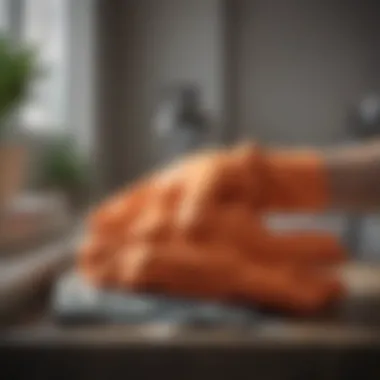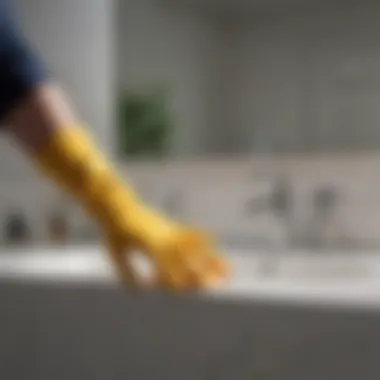Top Bathroom Cleaning Gloves: A Complete Guide


Intro
Cleaning the bathroom is one of those household chores that, while necessary, can feel like a daunting task. It’s not just the scrubbing and the sanitizing; it’s also about keeping your hands safe from harsh chemicals and bacteria. That's where gloves come in. Choosing the right pair of gloves can make a world of difference. They not only protect your skin but also enhance your grip and comfort during cleaning sessions. In this guide, we’ll dissect the different types of gloves available, delve into materials that bring durability and comfort, and illuminate the aspects that can improve your cleaning experience.
Why Use Gloves?
Using gloves while cleaning isn't just for the sake of fashion; it’s about practicality and protection. When tackling stubborn stains, foul odors, or using strong cleaning agents, gloves act as a barrier, keeping your hands safe from potential irritants. Think of them as your first line of defense. Beyond safety, there’s the comfort factor. The right gloves can make it feel less like a chore and more like a manageable task.
Design Inspirations
While we often concentrate on functionality, the design of your cleaning gloves shouldn’t be overlooked. The aesthetics of your cleaning gear can subtly influence your mood while you tackle those bathroom tiles.
Latest Trends in Cleaning Gear Design
The trend these days leans towards vibrant colors and eco-friendly materials. Consider gloves that not only provide protection but also align with the current design trends of cleanliness and harmony. Soft pastels or earthy tones can create a calming environment while you scrub away. Materials such as natural rubber or bamboo are gaining traction for those conscious about their environmental footprint.
Color Palettes and Themes
Besides functionality, picking the right color for your gloves can tie in with your overall bathroom decor. A bold turquoise can add a splash of life against a neutral theme, while more subdued tones can blend seamlessly with natural elements. Plus, coordinating your cleaning gear with your bathroom’s palette can make the task feel less mundane and bring a sense of style into an otherwise utilitarian task.
Functional Elements
On to functionality – it’s paramount that the gloves serve their purpose well.
Material Matters
With a variety of options out there, you may wonder, what should you look for? Here’s a helpful breakdown:
- Nitrile Gloves: These are your go-to for chemical resistance. Great for heavy-duty cleaning tasks.
- Latex Gloves: Comfortable and snug, these gloves offer excellent dexterity but might trigger allergies.
- Rubber Gloves: Classic and durable, perfect for general cleaning and scrubbing tasks.
Fit and Comfort
Don’t underestimate the importance of fit. Ill-fitting gloves can lead to discomfort and hinder your cleaning efficiency. Look for options that provide a snug fit around the wrist to prevent water from splashing in while still allowing good hand movement. Finding the right balance between grip and sensitivity can make your cleaning process more fluid.
Tip: Experiment with different sizes and brands until you find the perfect fit; your hands will thank you!
Intro
When it comes to maintaining a clean bathroom, choosing the right gloves can make all the difference. The importance of donning a pair of sturdy gloves transcends mere aesthetics; it’s about protecting your hands from harmful substances, ensuring hygiene whilst cleaning, and ultimately, enhancing your cleaning experience.
Cleaning a bathroom often means coming face-to-face with harsh chemicals, germs, and grime. The right pair of gloves not only acts as a barrier between these irritants and your skin but also empowers you to tackle even the toughest stains with confidence. Think of gloves as your second skin—an essential tool that brings comfort and safety to a task many of us would rather avoid.
Not all gloves are crafted equal; they come in a variety of materials, sizes, and designs. Each option caters to different cleaning tasks and preferences. For a homeowner or housewife looking to keep their space pristine, it’s crucial to understand how to choose gloves that fit your cleaning regimen.
Furthermore, wearing gloves is pivotal for hygiene. Bathrooms harbor a multitude of bacteria and fungi; protecting your skin is just as much about personal care as it is about cleanliness. In addition, many cleaning agents are abrasive, and prolonged exposure can wreak havoc on your skin, leading to irritation or allergic reactions.
In this guide, we'll explore the many crucial aspects of bathroom cleaning gloves, from material types and specific features to considerations when selecting the right pair for your individual needs. Whether your goal is to encase your hands in a layer of protection or ensure that your cleaning routine is as effective as possible, understanding the significance of gloves in bathroom cleaning is the first step to a thorough approach.
The Importance of Using Gloves for Bathroom Cleaning
When it comes to keeping the bathroom spick and span, the tools we choose play a crucial role. One might not give a second thought to a simple pair of gloves, but they are a pivotal line of defense. Wearing gloves while cleaning is not just a matter of personal preference; it is essential for safeguarding health and enhancing the cleaning experience.
Imagine going about your scrubbing and scouring with bare hands. It's a fast track to exposure to harmful chemicals, bacteria, and scrapes that can leave your skin in a sorry state. In a nutshell, donning gloves protects your hands while maximizing the efficacy of your cleaning efforts. Let’s dive into the specific benefits these gloves bring to the table.
Protection Against Chemicals
Household cleaning agents can be quite potent. Bleaches, disinfectants, and other cleaning solutions often contain harsh chemicals that can adversely affect your skin. Prolonged contact may lead to irritation, rashes, or even chemical burns.
"Your hands are perhaps the most vulnerable part of your body when it comes to cleaning. Protect them well!"
Using cleaning gloves acts as a barrier. Here are a few points to consider:


- Chemical Resistance: Many gloves are designed to withstand specific substances, minimizing the risk of absorption into your skin.
- Skin Sensitivity: If you have sensitive skin, the right pair of gloves will help you avoid reactions that could even lead to long-term skin conditions.
Hygiene Considerations
Bathrooms are breeding grounds for bacteria, mold, and other pathogens. When you clean, you often dislodge these microbes, putting your hands at risk of contamination. Without gloves, there's a fair chance something will cling to your skin, and there's no telling where that might lead.
Wearing gloves helps maintain hygiene in various ways:
- Prevent Cross-Contamination: Gloved hands can help you deter germs from spreading. You can tackle multiple surfaces without inadvertently transferring bacteria from one area to another.
- Easy to Disinfect: Once you're done with your cleaning spree, a simple rinse of your gloves keeps them hygienic, whereas washing your hands may involve more effort.
Skin Protection from Abrasives
Cleaning often requires scrubbing to dispel dirt and soap scum. This vigorous action can be abrasive, especially on delicate skin. Even if you don’t notice it immediately, consistent exposure can lead to dryness and irritation over time.
Gloves mitigate this risk significantly by:
- Adding a Layer of Protection: The material of cleaning gloves creates a cushion, shielding your skin from wear and tear caused by scrubbing.
- Keeping Hands Moisturized: Some gloves are designed not just for protection but also to maintain moisture levels in your hands, thereby preventing dryness that often comes with frequent cleaning.
Materials Used in Cleaning Gloves
When it comes to cleaning your bathroom, the material of the gloves you choose plays a crucial role in determining their effectiveness and your comfort. With a myriad of options available, understanding the different materials can help ensure a suitable choice for your specific cleaning needs. Selecting the right gloves can protect your skin, provide the right grip and prevent accidents due to slippage. In this section, we will delve into the characteristics, benefits, and considerations related to the primary materials used in cleaning gloves.
Latex
Latex gloves have a reputation for being both flexible and resilient. These gloves are crafted from natural rubber latex, offering a snug fit that allows for excellent dexterity—perfect if you're dealing with tight spots in your bathroom. One of the primary advantages of latex gloves is their ability to create a barrier against water and detergents while providing a comfortable, tactile sensation. However, there are significant considerations; some individuals may have latex allergies, which can lead to irritation or severe reactions. If you're prone to such allergies, it might be worth considering alternate materials. Still, for those who can wear them, latex gloves can be incredibly effective for general cleaning tasks, as they are often quite affordable compared to other materials.
Nitrile
Nitrile gloves are becoming increasingly popular, primarily because they offer a solid middle ground between latex elasticity and durability without the allergy concerns. These gloves are made from synthetic rubber, making them robust against punctures and tears, an essential factor when scrubbing hard surfaces in your bathroom. One of the strong points of nitrile gloves is their chemical resistance; if you're using harsh cleaning agents, nitrile is often the material of choice. Additionally, they fit snugly, enabling superior hand movement. While nitrile gloves tend to be a bit pricier than latex, they outlast many counterparts, providing long-term value, especially for heavy-duty cleaning tasks.
Vinyl
Vinyl gloves are a budget-friendly option that doesn't compromise too much on usability. Made from polyvinyl chloride (PVC), these gloves are generally looser fitting and don't provide as much tactile sensitivity as latex or nitrile. However, they can be a reasonable choice for light cleaning jobs where you might not need the same level of protection. Vinyl gloves are also less likely to cause allergic reactions, making them accessible for a broader audience. They work well when handling non-toxic substances but can wear out quicker. You might find that for rigorous scrubbing, you may need to switch them frequently due to thinner material.
Rubber
Rubber gloves, particularly the old-fashioned yellow ones we often find in kitchens, hold their ground as a classic cleaning choice. These gloves tend to have a thicker, more durable construction, making them ideal for tough jobs, including scrubbing away stubborn grime or dealing with heavy cleaning agents. Their main draw is their unmatched longevity—they can stand the test of time if taken care of properly. However, on the flip side, rubber can induce sweat accumulation, which might make cleaning less comfortable after a while. When using rubber gloves, it's advisable to keep your hands dry whenever possible to maintain overall comfort.
It's essential to choose cleaning gloves that not only fit well but also align with your skin’s needs and the cleaning tasks at hand.
In summary, the material of cleaning gloves impacts everything from your grip to the level of protection you’ll receive. Whether you opt for latex, nitrile, vinyl, or rubber, understanding each material’s strengths and weaknesses can make your cleaning sessions in the bathroom more efficient and enjoyable.
Factors to Consider When Choosing Bathroom Cleaning Gloves
Selecting the right bathroom cleaning gloves is not just about picking something off the shelf. It’s about finding a perfect match for your cleaning needs and ensuring your hands are well-protected while managing those tough cleaning chores. This section delves into key elements that play a crucial role in glove selection, helping you identify the best gloves to use for all your cleaning tasks.
Size and Fit
When it comes to gloves, the right size matters more than you might think. Ill-fitting gloves can lead to discomfort, making it harder to complete your cleaning tasks effectively. If they’re too tight, you might feel restricted, while gloves that are too loose can lead to slippage, reducing your grip and control. To gauge the right size, measure the circumference of your palm and refer to the glove manufacturer’s sizing guide. Remember, a snug fit enhances dexterity, allowing you to manipulate cleaning tools with ease. Investing in gloves that fit well can make your cleaning experience far more pleasant.
Length
The length of cleaning gloves can impact their functionality and your overall experience. Standard wrist-length gloves might suffice for light cleaning, but they often leave your forearms exposed to splashes and spills.
Consider longer gloves that reach mid-arm or even elbow-length for tasks that involve harsher chemicals or more extensive scrubbing. This added protection is especially handy when cleaning bathtubs, sinks, or toilets, where water and grime can easily make a mess.
Moreover, longer gloves can potentially keep your skin healthier by preventing those unfortunate rashes or irritation caused by direct contact with cleaning agents. Think of it as investing a little extra into your health; after all, prevention is worth a pound of cure!
Grip Ability
Don’t overlook the importance of grip when selecting your gloves. A strong grip can be the difference between a smooth cleaning session and a slippery disaster. Look for gloves with textured surfaces, as these can significantly enhance your ability to handle various cleaning tools securely.
Whether you’re scrubbing grout or handling glass cleaner, a solid grip is imperative to maintain control. For extra assurance, some gloves come fitted with additional features like wrist straps or ribbed cuffs that help prevent them from slipping off during use.


Ultimately, a glove that feels secure in your hand can boost your confidence as you tackle even the toughest cleaning challenges.
Choosing the right gloves is not just about comfort. It’s also about enhancing your cleaning efficiency while safeguarding your skin.
By paying close attention to size, length, and grip ability, you set yourself up for success in your cleaning endeavors. Avoid settling for flimsy options; take the time to choose gloves tailored to the tasks at hand, and your hands will thank you.
Best Gloves for Different Cleaning Tasks
Choosing the right gloves for different cleaning tasks in your bathroom is not just about comfort; it can greatly influence the effectiveness of your cleaning and your safety. Each task has its own demands, so understanding these nuances is key. For various cleaning jobs, certain features in gloves can enhance your performance and protect your hands from harsh cleaning agents and bacteria.
General Cleaning
General cleaning often involves a range of activities, from dusting surfaces to wiping down counters. It’s essential to select gloves that provide a good grip while allowing flexibility. A pair made from nitrile or latex is typically sufficient here. Nitrile gloves are particularly advantageous because they’re resistant to many cleaning chemicals, which makes them effective for most household cleaning purposes.
When engaging in general cleaning, consider gloves with a longer cuff to protect your wrists, as splashes can occur easily while scrubbing or wiping. Opt for gloves that fit snugly without being restrictive, as an ideal fit allows you to maneuver with ease and prevents fatigue.
Heavy-Duty Scrubbing
For heavy-duty scrubbing tasks, you’re likely looking at tough stains and the application of more abrasive cleaning products. When faced with this kind of challenge, durability becomes your best friend. Look for rubber cleaning gloves or thicker nitrile options that offer added protection. These materials provide excellent resistance to chemicals and ensure your hands are insulated from harsh scrubbing pads.
Not only does a thicker glove provide better protection, it also reduces the risk of tearing when you scrub vigorously. A glove that extends further up the forearm can help vault over debris and cleaning solutions that might otherwise make contact with your skin during rigorous cleaning.
Bathroom Disinfection
Disinfection is non-negotiable when it comes to bathroom cleaning, given the high level of bacteria found in this space. Here, flexibility and chemical resistance are paramount. Gloves made from latex or nitrile are often recommended for disinfection tasks. Latex is known for its snug fit and comfort, but if you have latex allergies, nitrile is a safe alternative that doesn’t compromise on protection.
When disinfecting, pay attention to the glove's intended purpose. Check if the gloves are rated for handling disinfectants, as some materials may degrade when exposed to certain chemicals. Ensuring a seamless barrier against harmful germs is key in reducing the risk of contamination.
Glass and Mirror Cleaning
Cleaning glass and mirrors may seem less demanding, but it requires a specific approach. You want gloves that not only protect your skin but also enhance your grip to avoid mishaps with glass cleaners. Look for vinyl gloves for lighter tasks, as they are often used in light cleaning. They can protect your hands from streaky glass cleaners while allowing you to maintain excellent dexterity.
However, if you’re using heavier spray cleaners or scrubbing pads, invest in long-lasting nitrile gloves for added resilience. Good grip is crucial here, as it prevents slips which could lead to breakage or injury.
Important: Always ensure that your gloves are compatible with the cleaning products being used for the task at hand. This prevents degradation of the glove material that may lead to protection failure.
Top Recommendations for Bathroom Cleaning Gloves
When it comes to effective bathroom cleaning, the right pair of gloves can make all the difference. This section highlights the top recommendations for bathroom cleaning gloves, carefully considering different aspects such as material quality, ease of use, and performance under a variety of circumstances. It aims to guide readers in choosing gloves that offer a blend of durability, comfort, and specialized functionality to meet their diverse cleaning needs. The right gloves protect your hands and empower you to tackle tough jobs with ease.
Best Overall Gloves
For those seeking a well-rounded option, CleanGuard Premium Latex Gloves rise to the occasion. They're flexible, fitting close to your skin and allowing for great mobility. Made of latex, they offer superb resistance against cleaning chemicals, making them ideal for everyday bathroom chores. One of the standout features is their textured grip, ensuring that wet or soapy surfaces don’t turn your spray bottle into a slippery challenge. Plus, they come in various sizes, making it easy to find a fit that feels just right.
Best Budget-Friendly Option
If you're on the lookout for a wallet-friendly choice, Vinyl Clean gloves are a solid pick. These gloves offer a no-frills alternative without skimping on performance. Although they might not provide the same level of protection against harsher chemicals as latex, they're more than adequate for light cleaning tasks. Their price point makes them appealing for those who clean regularly but might not need to splurge too much on a premium option. This budget-friendly model also provides a wider range of sizes, ensuring you find the right length and width without breaking the bank.
Most Durable Gloves
For those who need something that will truly stand the test of time, Showa 377 Nitrile Gloves can withstand heavy-duty scrubbing while still protecting your hands from both abrasives and harsh chemicals. Their unique design prevents tearing and puncturing, and unlike some rubber gloves, they provide full-hand dexterity. The internal coating of the glove enhances comfort, making extended cleaning sessions a lot more tolerable. This option is perfect for those who routinely tackle grime that requires some serious elbow grease.
Best for Sensitive Skin
Those with sensitive skin often struggle with common cleaning gloves that can cause irritation or allergic reactions. The Ecover Bio Rubber Gloves are crafted from natural rubber, providing a gentle touch while still being robust enough for cleaning chores. These gloves are free from allergens and use a technology that minimizes sweating. With a snug fit and natural feel, they ensure your hands stay protected without sacrificing comfort. It's a game changer for individuals who may feel butted up against the wall when it’s time to tackle cleaning duties.
"Choosing the right cleaning gloves is essential not just for task completion but also for the well-being of your skin. It's an investment in your health."
Having a shortlist of these recommended gloves can make your bathroom cleaning more efficient and enjoyable. Whether you’re scrubbing tiles or disinfecting surfaces, the right pair can transform your cleaning routine. By assessing your specific needs—whether durability, budget, skin sensitivity, or overall utility—you’ll go a long way toward maintaining a cleaner home without compromising your comfort.
Proper Care and Maintenance of Cleaning Gloves


Taking care of cleaning gloves is just as important as picking the right pair. Proper maintenance not only extends the life of these essential tools but also safeguards your health. Neglecting to care for your gloves can lead to wear and tear, compromising the very protection you seek while wielding them against dirt and grime. Moreover, improperly cleaned gloves can harbor bacteria, which defeats their purpose in keeping your hands safe from contamination.
Cleaning and Storing Your Gloves
To get the most out of your cleaning gloves, it's crucial to start with a solid cleaning routine. After each use, rinse them in warm water, making sure to remove any detergent or cleaning solutions that may have clung to the material. For a deeper clean, especially after tackling tough jobs, consider using mild soap. Avoid harsh chemicals that can break down the glove's material.
After rinsing, gently wipe them down using a soft cloth or let them air dry after turning them inside out. Never hang wet gloves on a hook or in direct sunlight, as this can lead to deterioration. Instead, store them flat or rolled, away from extreme temperatures and humidity. Regularly inspect your gloves for any signs of damage, which leads us nicely into the next point.
When to Replace Your Gloves
Even the best gloves won’t last forever. Knowing when to toss them can make a significant difference. If you notice cracks, tears, or discoloration, it’s time to say goodbye. Also, keep an eye out for any strong odors that seem to linger. These can indicate bacterial growth, making it imperative to replace them, regardless of their physical appearance.
Here are some signs indicating a change is in order:
- Visible wear or tears in the material
- Strong or lingering odors
- Reduced elasticity, making them fit improperly
- Not providing a secure grip anymore
Ultimately, putting in the effort to care for and monitor your cleaning gloves will not only save you personal expenses over time but also fortify your cleaning regimen. A little diligence goes a long way to maintaining their role as crucial allies in your bathroom cleaning adventures.
The End
In this article, we’ve navigated the intricate world of cleaning gloves, emphasizing their pivotal role in bathroom maintenance. Choosing the right pair of gloves is not simply a matter of comfort; it’s about ensuring safety and enhancing the effectiveness of your cleaning routine.
Understanding the specific elements discussed is crucial. For one, the variety of materials—from latex to nitrile—allows individuals to select gloves that cater to their unique skin sensitivities and the specific cleaning challenges they face. For example, latex gloves provide excellent flexibility but might not be suitable for those with latex allergies. On the other hand, nitrile gloves offer durability and resistance to punctures and chemicals, making them an ideal choice for more rigorous tasks.
Furthermore, proper fit and design can dramatically impact how you approach your cleaning chores. Ill-fitting gloves can lead to frustration and hinder performance, which is the last thing anyone needs when tackling the often daunting bathroom cleaning tasks. As discussed, taking the time to determine your size and grip ability can make all the difference, allowing you to work efficiently without worrying about slippage or discomfort.
Ultimately, the care and maintenance of these gloves cannot be overstated. Regular cleaning and timely replacements ensure that you have reliable protection against hazardous chemicals and germs entering your skin. Taking this small step can contribute immensely to overall hygiene in your environment.
"The right gloves can transform your cleaning experience—protection and efficiency go hand in hand."
By synthesizing this information, it’s clear that investing in quality gloves tailored to your bathroom cleaning needs not only safeguards your skin but enhances your housekeeping abilities. This guide empowers you to make informed choices, ensuring that each cleaning session is both effective and safe. So next time you reach for the mop or toilet brush, remember that a good pair of gloves is not just an accessory but an indispensable tool in the fight against dirt and germs.
Frequently Asked Questions
In this section, we address common queries that often arise when it comes to selecting the right gloves for bathroom cleaning tasks. Understanding these frequently asked questions enhances the overall cleaning experience by providing insights that help buyers make informed decisions. It’s not just about choosing a product; it’s about knowing why specific features matter, the importance of fit, and the best materials to suit individual needs. This section can be beneficial for readers looking to fine-tune their cleaning approach while protecting their hands.
Can all gloves be used for cleaning?
Not every glove on the market is designed for cleaning purposes. While it may be tempting to grab any old pair lying around, it’s crucial to understand the nuances of glove suitability. Kitchen gloves, garden gloves, and disposable gloves may look fine, but they often lack the necessary durability and chemical resistance required for bathroom cleaning.
For instance, some cotton gloves might be prone to wear when they come into contact with strong disinfectants. If you use gloves made from inappropriate materials, your hands can become damaged, or worse, exposed to harmful chemicals.
Key considerations include:
- Material: Look for gloves made from latex, nitrile, or rubber for superior protection.
- Thickness: Thicker gloves tend to offer better durability, especially for rigorous scrubbing tasks.
- Fit and Comfort: Gloves that fit snugly will provide better dexterity and reduce the chance of accidental slips.
In summary, not all gloves fit the bill—choose wisely to ensure both safety and efficacy in your cleaning routines.
What type of gloves are best for sensitive skin?
When it comes to sensitive skin, extra caution is essential. Many common glove materials can trigger allergic reactions. For those suffering from skin sensitivities, nitrile gloves are often the best choice. They are both resistant to punctures and latex-free, reducing the risk of irritation.
On the other hand, some people prefer to go the natural route by opting for hypoallergenic latex gloves, though these can cause issues for others.
Benefits of selecting the right gloves if you have sensitive skin include:
- Protection from Irritants: Helps avoid contact with harsh cleaning chemicals that can aggravate skin conditions.
- Comfort: Better materials make for a more enjoyable cleaning experience, allowing you to focus on the task at hand.
- Durability: High-quality gloves made for sensitive skin typically last longer than cheaper alternatives, offering better long-term value.
To sum it up, prioritize material safety and comfort when shopping for gloves.
How do ensure a good fit?
Finding the perfect glove fit is crucial for effective cleaning. A well-fitted glove enhances dexterity, making it easier to grip tools and clean hard-to-reach areas. Here are a few steps to ensure you find the right pair:
- Measure Your Hands: Use a tape measure to determine the widest part of your palm, and refer to size charts provided by manufacturers.
- Try Them On: If possible, try on the gloves. Make sure they feel snug but not overly tight; you should be able to move your fingers easily.
- Check for Length: The gloves should ideally cover your wrists to provide protection against splashes and spills.
- Look for Elastic Cuffs: Gloves with stretchy cuffs or snug wrist bands prevent water and cleaning solutions from seeping in.
A well-fitting glove not only protects your skin but also increases your cleaning efficiency.
By taking these steps, you can ensure that your gloves not only fit well but also feel comfortable during those long cleaning sessions.















